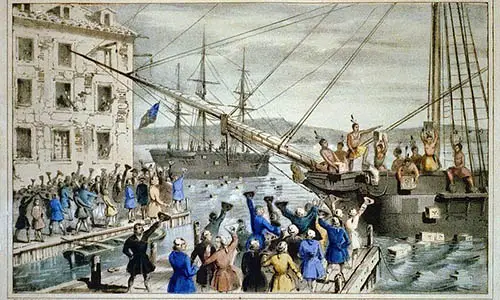The Boston Tea Party occurred on December 16, 1773. It was a confront by the American Colonists against the British as to the tea charges that had been forced on them. This confront included tossing midsections of tea from three British exchange ships into the Boston Harbor. The settlers were directed to purchase tea only from the British-claimed East Indian Trading Company. The British had forced tea charges through the Tea Act, and the settlers rebelled by wearing outfits, boarding the boats, and dumping the tea load into the harbor. The Boston Tea Party was a key occasion that prompted the start of the American Revolution.
At nine o’clock on the night of December 16, 1773, a band of Bostonians camouflaged as Native Americans loaded up the British carter ships the Dartmouthand, the Eleanor, and the Beaver tied down at Griffin’s Wharf in Boston harbor. The Americans, who numbered around 70, had a clear and same motive: to devastate the ships’ freight of British East India Company tea.
Here, we have some interesting facts about the Boston Tea Party:
- The Tea Act, passed by the Parliament on May10, 1773, allowed the British East India Company Tea an imposing business model on tea deals in the American settlements. This was what at last, led to the gathering of Sons of Liberty individuals on the night of December 16, 1773 to mask themselves as Mohawk Indians, board three boats moored in Boston Harbor, and annihilate more than 92,000 pounds of tea.
- After raising pressure with the British, the Boston Tea Party was a demonstration of resistance by the Sons of Liberty particularly against the Tea Act of 1773.
- The saying, “no imposition of taxes without any political benefit” is a motto that alludes to the way that the homesteaders of the thirteen provinces felt their rights were being taken away by the British Parliament in light of the fact that they were being saddled, yet not being spoken to in the Parliament.
- Governor Thomas Hutchinson of Massachusetts was also against the Tea Act being imposed on the Americans, but, he was eventually condemned for not requesting that the tea-conveying boats be sent back to England without payment.
- Angry pioneers met at the Old South Meeting House on the morning the boats were expected in the harbor. They consented to make an impression on the traditions house at the harbor, saying that the boats would not be paid for the tea.
- On the day of the Boston Tea Party, December 16, 1773, the political gathering, The Sons of Liberty, spruced up as Mohawk Indians and struck three boats docked in Boston Harbor delivering tea from the East India Company.
- The precise area of the Tea Party is questionable, it is accepted to have been close to the end of Hutchinson Street which is presently named Pearl Street.
- An aggregate of 342 midsections of tea were wrecked in the strike and tossed over the edge trying to keep the tea from being sold or expended.
- The Tea Act was an administration bailout for an organization on the edge of budgetary breakdown, the thrashing East India Company, which was considered to be, in cutting edge terms, “too huge to fall flat.” The enactment gave the East India Company a virtual imposing business model on the American tea exchange, permitting it to sidestep provincial traders as mediators and to try and undercut the cost of snuck Dutch tea, which was generally expended in the states.
- George Washington emphatically voiced his dissatisfaction with “their behavior in wrecking the Tea.” Washington, in the same way as other different elites, held private property to be hallowed and accepted the culprits ought to repay the East India Company for the harms.
- The British reaction to the Boston Tea Party was a progression of acts went for rebuffing the homesteaders and restoring request, the first of which was the Boston Port Act. This demonstration shut the port at Boston Harbor to further exchange until the British were reimbursed for harms and for the tea.
- This occasion was not named the Boston Tea Party until the mid 1800s preceding that it was alluded to as the “devastation of the tea”.
- There is a Boston Tea Party Museum situated in Boston. It houses numerous ancient rarities including a genuine tea midsection from the Boston Tea Party.











Leave a Reply